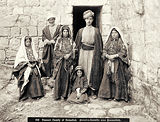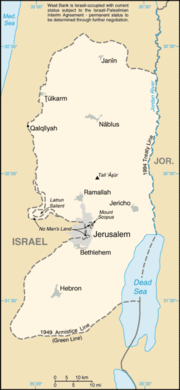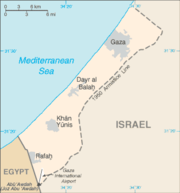Palestinian territories
2008/9 Schools Wikipedia Selection. Related subjects: Middle Eastern Countries
The Palestinian territories is one of a number of designations for those portions of the British Mandate of Palestine captured and administered by Jordan and by Egypt in the late 1940's, and later by Israel following the 1967 Six-Day War.
Today, the designation typically refers to the territories governed in varying degrees by the Palestinian Authority (42% of the West Bank plus all of the Hamas-ruled Gaza Strip), or includes all of the West Bank and Gaza Strip. It does not include the Golan Heights captured from Syria during the Six Day War, or the Sinai Peninsula, captured from Egypt at that time but later returned by Israel to Egypt after a peace accord was signed between the two countries in 1979. Israel does not consider East Jerusalem nor the former Israeli - Jordanian no man's land (both annexed in 1967) to be parts of the West Bank. Both in fact fall under full Israeli law and jurisdiction as opposed to the 58% of the Israeli-defined West Bank which is ruled by the Israeli ' Judea and Samaria Civil Administration'.
Name
Other terms used to describe these areas collectively are "the disputed territories", " Israeli-occupied territories", and "the occupied territories". Further terms include " Yesha" (Judea-Samaria-Gaza), "liberated territories", "1967 territories", and simply "the territories".
The United Nations generally uses the term "Occupied Palestinian Territory", with the "Palestinian" label having gained use since the 1970s. Previous UNSC resolutions (such as 242 and 338) use the term "territories occupied by Israel", whereas in the UN General Assembly Resolution 181 passed on November 29, 1947, the term " Samaria and Judea" was used. Many Jews object to the term "Palestinian territories", which they perceive as a rejection of what is in their view legitimate Jewish land according to written history of the Mediterranean including Greek and Roman writings, the Hebrew Bible and indigenous Jewish history (and current settlements) in the area. Additionally, the term "Palestinian" had also been applied for many years to Palestinian Jews in the same region.
Political status
The political status of these territories has been the subject of negotiations between Israel and the Palestine Liberation Organization (PLO) and of numerous statements and resolutions by the United Nations. See List of United Nations resolutions concerning Israel for further details.
The current and future political status of the territories is highly controversial. Specific issues include the legality of Israeli's policy of encouraging settlement, whether it is legitimate for Israel to annex portions of the territories, whether Israel is legally an occupying power according to the Fourth Geneva Convention, and whether an independent Arab state will be created in the territories.
Since 1994, the autonomous Palestinian Authority has exercised various degrees of control in large parts of the territories, pursuant to the Oslo Accords.
Since the Battle of Gaza (2007), the territories have split into two administrative entities, with Hamas leading the Gaza Strip and the Palestinian National Authority (with Mahmoud Abbas of Fatah in leadership) continuing to administer the West Bank despite the election (in January, 2006) of Hamas to the majority of seats in the Palestinian Legislative Council. Neither group recognize the other one as the official Palestinian leadership.
Boundaries
The boundaries between the West Bank and the Gaza Strip and the State of Israel, known as the Green Line, are a result of the 1949 Armistice Agreements after the 1948 Arab-Israeli War, while their boundaries with Jordan and Egypt follow the international border negotiated in the Israel-Egypt peace treaty and Israel-Jordan peace treaty. The natural geographic boundaries for the West Bank and the Gaza Strip are the Jordan River and the Mediterranean Sea, respectively.
Between 1949 and 1967, these territories were occupied by Jordan and Egypt respectively, but the term "Palestinian territories" or "Occupied Palestinian Territories" gained wide usage after Israel's victory in the 1967 Six-Day War, about the same time as the term "Palestinian" first started to be used exclusively in respect to Arab population of Palestine. Since then, the United Nations and most foreign governments regard the territories as being under Israeli military occupation.
Since 1994, the autonomous Palestinian Authority has exercised various degrees of control in large parts of the territories, pursuant to the Oslo Accords.
Since the Battle of Gaza (2007), the territories have split into two administrational entities, with Hamas leading the Gaza Strip and the Palestinian Authority (with Fatah in leadership) leading the West Bank.
The Term "Occupied Palestinian Territories"
Generally, the term "Occupied Palestinian Territories" is used by:
- International Community, consisting of all members of the United Nations with the exception of seven states, since 1967-present.
- International Court of Justice, since 1967-present.
- journalists, since 1967-present, to indicate lands where Arab Palestinians presently dwell, outside the Green Line, or the 1949 Armistice lines;
The term is often used interchangeably with the term Occupied territories, although the latter refers to an inclusive set of both the "Palestinian territories" and the Golan Heights. The Golan is not settled by Palestinians nor claimed by them, but rather by Syria, though the tiny Shebaa Farms area is also claimed by Lebanon. The confusion stems from the fact that all these territories were captured by Israel during the 1967 Six-Day War and are regarded by the United Nations as being illegally occupied by Israel.
The term "Occupied Palestinian Territories" is challenged by some Israelis because it may either disregard Israeli claims to the territories or possible border change after the 1948 Arab-Israeli War. Israeli right-wing politician Shmuel Katz, in a preliminary brief, whose arguments were analysed and dismissed later by the International Court of Justice to which it was directed, rejects the rulings of that Court and, with it, resolutions of the United Nations Security Council, asserting that the standard term in international law, "occupied Palestinian lands" is "the common language of Arab anti-Israel propaganda, a part of the Arabs' fictional history, which it has succeeded in disseminating throughout the whole wide world". Katz further claimed that "Impartial groups should not be blind to the fact that there are two sides to the dispute in Palestine, and that Israel rejects absolutely the notion that it is illegally holding 'Palestinian lands'." Similary, the Jerusalem Centre for Public Affairs has written: "It would be far more accurate to describe the West Bank and Gaza Strip as "disputed territories" to which both Israelis and Palestinians have claims"
| History of the Levant |
| Stone Age |
|---|
|
Kebaran · Natufian culture · |
| Ancient History |
|
Sumerians · Ebla · Akkadian Empire · |
| The Middle Ages |
|
Umayyad · Abbasid · Fatimid |
| Modern Times |
|
British Mandate of Palestine |
|
|
In 1922 after the collapse of the Ottoman Empire that ruled Palestine for four centuries (1517-1917), the British Mandate for Palestine was established. Large-scale Jewish immigration from abroad, mainly from Eastern Europe took place during the British Mandate. The future of Palestine was hotly disputed between Arabs and Jews. In 1947, the total Jewish ownership of land in Palestine was 1,850,000 dunums or 1,850 square kilometers, which is 7.04% of the total land of Palestine. Public property or "crown lands", the bulk of which was in the Negev, belonging to the government of Palestine may have made up as much as 70% of the total land; with the Arabs, Christians and others owning the rest.
The 1947 United Nations Partition Plan proposed a division of the mandated territory between an Arab and a Jewish state, with Jerusalem and the surrounding area to be a corpus separatum under a special international regime. The regions allotted to the proposed Arab state included what would become the Gaza Strip and almost all of what would become the West Bank, as well as other areas.
The Partition Plan was passed by the UN General Assembly on November 1947. Israel declared its independence on May 14, 1948, one day before the expiration of the British Mandate for Palestine. US President Harry Truman recognized the State of Israel de facto the following day, and the United States recognized it de jure on January 31, 1949. ( http://www.archives.gov/education/lessons/us-israel/) The Arab countries responded by declaring war on the newly formed State of Israel, which ended in Israel's victory.
After the war, Israel controlled many of the areas designated for the Arab state, and the negotiated agreements established Armistice Demarcation Lines (ADLs), which did not have the status of recognised international borders.
Thus the areas held by Jordanian and Iraqi forces (with minor adjustments) came under Jordanian control, and became known as the West Bank (of the Jordan River, by contrast with the East Bank, or Jordan proper); the area held by Egyptian forces, along the Mediterranean coast in the vicinity of the city of Gaza and south to the international border, remained under Egyptian control and became known as the Gaza Strip.
For nineteen years following the 1949 Armistice Agreements until the 1967 Six Day War, Egypt occupied the Gaza Strip and Jordan occupied the West Bank and East Jerusalem, and no Arab state was created. In 1950, Jordan annexed the territories it occupied; this annexation was not officially recognized by other countries, with the sole exception of the United Kingdom (but not, as is often said, Pakistan).
Article 24 of the Palestinian National Charter of 1964 stated: "This Organization does not exercise any territorial sovereignty over the West Bank in the Hashemite Kingdom of Jordan, on the Gaza Strip or in the Himmah Area."
Israel captured both territories in the 1967 Six-Day War; since then they have been under Israeli control. Immediately after the war, on June 19, 1967, the Israeli government offered to return the Golan Heights to Syria, the Sinai to Egypt and most of the West Bank to Jordan in exchange for peace. At the Khartoum Summit in September, the Arabs responded to this overture by declaring "no peace with Israel, no recognition of Israel and no negotiations with Israel." ( http://www.mideastweb.org/khartoum.htm)
UN Security Council Resolution 242 introduced the " Land for Peace" formula for normalizing relations between Israel and its neighbors. This formula was used when Israel returned the Sinai Peninsula to Egypt in 1979 in exchange for a peace treaty. While that treaty mentioned a "linkage" between Israeli-Egyptian peace and Palestinian autonomy, the formerly Egyptian-occupied territory in Gaza was excluded from the agreement, and remained under Israeli control.
The Oslo Accords of the early 1990s between the Palestine Liberation Organization and Israel led to the creation of the Palestinian Authority. This was an interim organization created to administer a limited form of Palestinian self-governance in the territories for a period of five years during which final-status negotiations would take place. The Palestinian Authority carried civil responsibility in some rural areas, as well as security responsibility in the major cities of the West Bank and the Gaza Strip. Although the five-year interim period expired in 1999, the final status agreement has yet to be concluded despite attempts such as the 2000 Camp David Summit, the Taba summit, and the unofficial Geneva Accords.
In 2005, Israeli forces withdrew from the Gaza Strip, ceding full effective internal control of the territory to the Palestinian Authority.
Since the Battle of Gaza (2007) the two separate territories, the Gaza Strip and the West Bank, are divided into a Hamas leadership in the Gaza Strip and a Fatah civil leadership in the autonomous areas of the West Bank. Each sees itself as the administrator of all Palestinian territories and does not acknowledge the other one as the official government of the territories. The Palestinian territories have therefore de facto split into two entities.
Legal status
| Palestinians |
 |
| Demographics & geography |
|---|
|
Definitions · Palestine |
| Politics |
|
Hamas · PLO · PNC · PLC · PFLP |
| Religion & religious sites |
|
Christianity · Islam |
| Culture |
|
Art · Costume & embroidery |
| Notable Palestinians |
|
Hany Abu-Assad |
|
|
The final status of the "Palestinian territories" as becoming (wholly or largely) an independent state for "Arabs" is supported by the countries that back the Quartet's " Road map for peace". The government of Israel also accepted the road map but with 14 reservations .
Although Israeli settlements were not part of the Oslo Accords negotiations, the Arab position is that the creation and the presence of Israeli settlements in those areas is a violation of international law. This has also been affirmed by a majority of members of the Geneva convention: "12. The participating High Contracting Parties call upon the Occupying Power to fully and effectively respect the Fourth Geneva Convention in the Occupied Palestinian Territory, including East Jerusalem, and to refrain from perpetrating any violation of the Convention. They reaffirm the illegality of the settlements in the said territories and of the extension thereof. They recall the need to safeguard and guarantee the rights and access of all inhabitants to the Holy Places."
East Jerusalem, captured in 1967, was unilaterally annexed by Israel. The UN Security Council Resolution 478 condemned the Jerusalem Law as "a violation of international law". This annexation has not been recognized by other nations, although the United States Congress has declared its intention to recognize the annexation (a proposal that has been condemned by other states and organizations). Because of the question of Jerusalem's status, some states refuse to accept Jerusalem as the capital of Israel, and treat Tel Aviv as the capital, basing their diplomatic missions there. Israel asserts that these territories are not currently claimed by any other state, and that Israel has the right to control them.
Israel's position has not been officially accepted by most countries and international bodies. The West Bank, and the Gaza Strip have been referred to as occupied territories (with Israel as the occupying power) by Palestinian Arabs , the rest of the Arab bloc, the UK , the EU, (usually) the USA ( , ), both the General Assembly and the Security Council of the United Nations , the International Court of Justice, and the Israeli Supreme Court (see Israeli West Bank barrier). The United Nations did not declare any change in the status of the territories as of the creation of the Palestinian National Authority between 1993 and 2000. Although a 1999 U.N. document (see the link above) implied that the chance for a change in that status was slim at that period, most observers agreed that the Palestinian territories' classification as occupied was losing substantiality, and would be withdrawn after the signing of a permanent peace agreement between Israel and the Palestinians (see also Proposals for a Palestinian state).
During the period between the 1993 Oslo Accords and the Second Intifada beginning in 2000, Israeli officials claimed that the term "occupation" did not accurately reflect the state of affairs in the territories. During this time, the Palestinian population in large parts of the territories had a large degree of autonomy and only limited exposure to the IDF except when seeking to move between different areas. Following the events of the Second Intifada, and in particular, Operation Defensive Shield, most territories, including Palestinian cities (Area A), are back under effective Israeli military control, so the discussion along those lines is largely moot.
In the summer of 2005, Israel implemented its unilateral disengagement plan; about 8500 Israeli citizens living in the Gaza Strip were forcibly removed from the territory; some received alternative homes and a sum of money. The Israeli Defence Forces vacated Gaza in 2005, but invaded it again in 2006 in response to rocket attacks and the abduction of Israeli soldier Gilad Shalit by Hamas.
The Palestinian territories have been assigned a country code of PS in ISO 3166-1 alpha-2, and accordingly, the Palestinian Authority was granted control of the corresponding Internet country code top-level domain .ps.
United Nations Security Council Resolution 242
United Nations Security Council Resolution 242 (S/RES/242), one of the most commonly referenced UN resolutions in Middle Eastern politics, was adopted unanimously by the UN Security Council on November 22, 1967 in the aftermath of the Six Day War. It was adopted under Chapter VI of the United Nations Charter, and was reaffirmed by UN Security Council Resolution 338, adopted after the 1973 Yom Kippur War.
The resolution calls for the "withdrawal of Israeli armed forces from territories occupied in the recent conflict" (there has been some disagreement about whether this means all the territories: see UN Security Council Resolution 242: semantic dispute) and the "[t]ermination of all claims or states of belligerency". It also calls for the mutual recognition by the belligerent parties (Israel, Egypt, Syria, Jordan) of each other's established states and calls for the establishment of secure and recognized boundaries for all parties.

